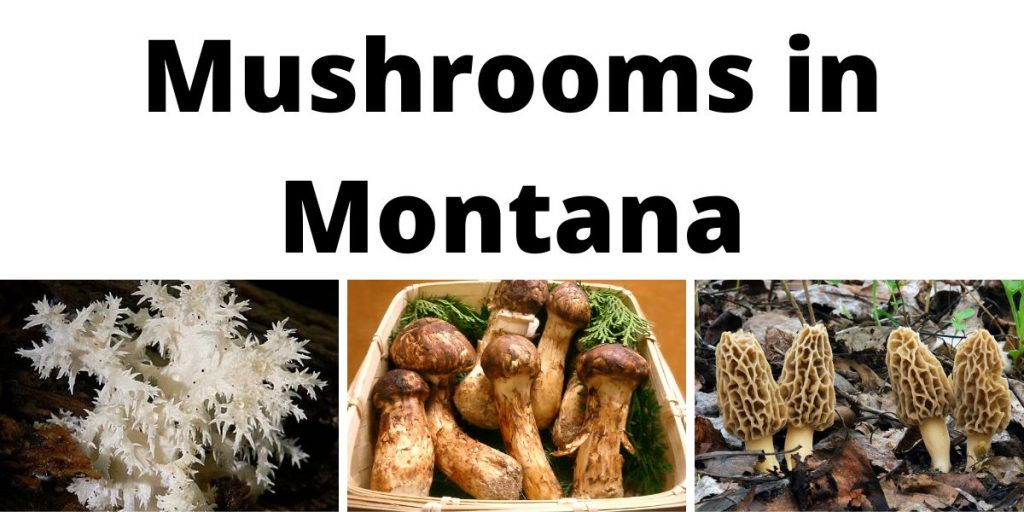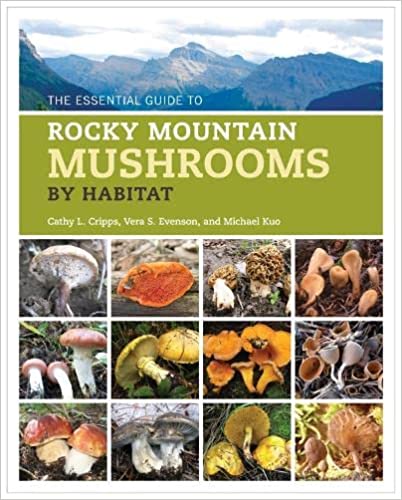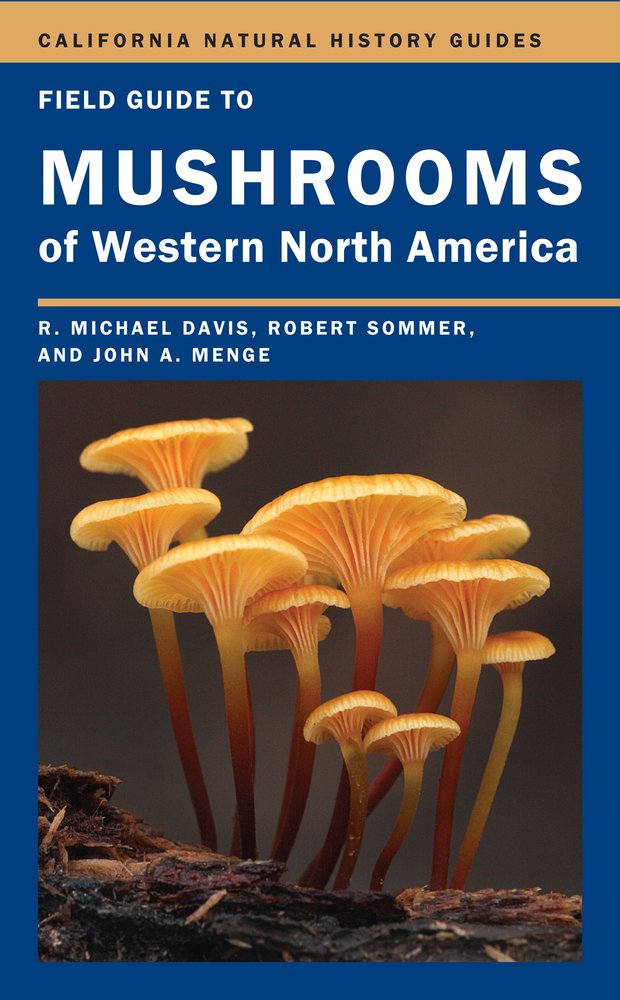Montana is famous for its wide-open country, its grizzly bears, and its wolves. It has some pretty impressive mushrooms, too, though we can’t possibly list all of them, there are too many. Instead, we can give you a quick introduction, a hint, at what the state as to offer[i][ii].
You can find lots of articles online claiming to tell beginners how to forage for a couple of fool-proof, delicious mushrooms. This is not one of those articles. It’s not that mushrooms are especially dangerous—very few of them are actually poisonous, and most of those that are cause only mild to moderate illness. It’s that there is no such thing as a “foolproof” species, and dangerous mistakes, though unlikely, are possible. Foraging safely takes know-how and experience, so beginners should start by identifying mushrooms without expecting to eat them. Learning from an experienced forager helps, too.
If you do indeed go Mushroom Hunting make sure you have the proper tools, take a quality knife with you and a basket/bag for your haul!
The point of this article is to show you why putting in the work to become an experienced forager is worth it. This list is not meant to be used as a replacement for a field guide, spore prints, an identification app or an in person guide.
Our Recommended Field Guides for Montana
COVER | TITLE | Header | ||
|---|---|---|---|---|
OUR #1 RATED | ||||
Edible Mushrooms in Montana
Rainbow Chanterelle (Cantharellus roseocanus)
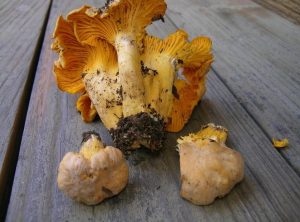

The Chanterelles are an interesting group in that it’s easy to tell that something is a chanterelle, but not so easy to tell which Chanterelle it is. All the large, yellow ones (which is to say, most of them) tend to get mistaken for a single species, the prized Golden Chanterelle. But many of the others, such as this one, the rainbow, are really just as good to eat, so the mistake doesn’t matter much. Chanterelles are Trumpet-shaped and have ridges or veins rather than gills.
Morels (Morchella sp.)




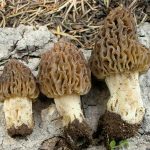

Morels are another distinctive-looking group of mushrooms that are hard to tell apart, to the point that many writers get mixed up about which ones are which. The various species in Montana mostly fall into either of two groups: yellow morels, such as Morchella americana, and Black Morels, such as Morchella septimelata and Morchella snyderi. All share the characteristic narrow cap with pits like a honeycomb, and all are delicious.
It is worth noting that morels occasionally make people ill. It is important to cook morels (most mushrooms should be cooked before being eaten), but even properly cooked ones sometimes cause a problem. It is not clear why. It is best to to eat too many at a time, just in case.
Chicken (Laetiporus sp.)


Chicken-of-the-woods is a whole flock of similar species that until relatively recently was thought to be just one species. Many writers still refer to it as a single species with the old scientific name.
The reason it matters is that not all chickens are equally edible.
Chicken-of-the-woods are, generally, yellow and orange, though some are pink and some are partly white. They are bracket-shaped and fruit in clusters from the sides of trees. They have pores rather than gills, but are not as tough as most bracket fungi. They are often suggested as perfect for beginning foragers, because they are relatively easy to recognize and actually do taste like chicken.
But some species of chicken-of-the woods are tough, leaving only the margins edible, and some are even mildly toxic. Unfortunately, so many people are still convinced that all chickens are alike, it is difficult to find out which species Montana actually has. It’s best to approach the group with a bit of caution.
Coral Mushroom (Hericium coralloides)
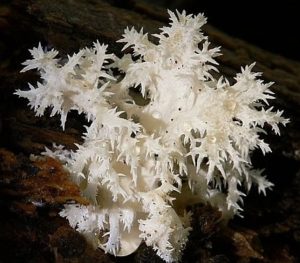

The Hericiums are a small group of peculiar fungi. They are covered all over with hairlike spines (these release the spores) and, even more surprisingly, they taste good (rather like crab meat) and don’t have a strange or objectionable mouthfeel at all. The spines just aren’t noticeable. One member of the group is club-shaped under the spines, but the others branch. As the Coral Mushroom has relatively short spines, the branching structure is more obvious, so it does resemble certain species of soft coral.
The Coral Mushroom should not be confused with the Coral Mushroom Group—they don’t look alike, but the names could cause a problem. It’s also worth noting that some writers insist that all Hericiums are medicinal and, as such, interchangeable—and we don’t know that they aren’t, but really only one Hericium species (Lion’s Mane) has been studied for its medicinal potential, and it wasn’t this one. So we don’t know, yet. Don’t let anyone tell you different.
Apricot Jelly (Guepinia helvelloides)
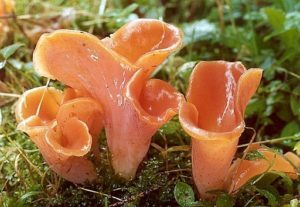

Speaking of strange-looking mushrooms, here is apricot jelly. It is trumpet-shaped, smooth, and bright pink, with a firm, gelatinous texture. Older specimens can get too tough, but young ones are good to eat—not that they taste like much. They are usually described as bland or slightly sweet. They are good to put in salads, mostly for color. They also reportedly make excellent candy when boiled in sugar like fruit.
King Bolete (Boletus sp.)
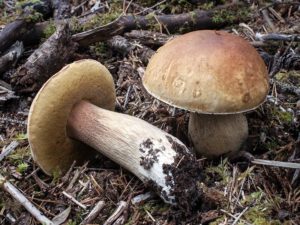

Once again, here we have a group of species that until recently was thought to be just Boletus edulis. Writers often still refer to it as the one, so it’s hard to get clear information about which one Montana has. In any case, king boletes, also known as porcini, or by half a dozen other common nicknames, are popular among foragers, reputed to taste excellent. The adjective “delicious” appears to apply to the entire group.
Boletes have a layer of pores rather than gills, but they also have the classic, parasol-like mushroom shape. Many boletes are safe to eat, though few others are as good as the kings, but there are a few toxic boletes to watch out for.
Hedgehog (Hydnum sp.)
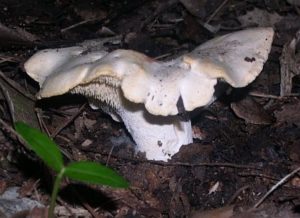

Hedgehog mushrooms are another group previously thought to be a single species[iii]. What usually happens with these things is that someone discovers a species in Europe, then applies the same name to similar-looking mushrooms in other parts of the world. Later, it turns out that the European species grows only in Europe, and that the others are all something else. And then because everybody is used to the old species definition—which is still in all the field guides—you get lists of species for, say, an American state, that includes mushrooms that don’t grow in North America. So while we can say with confidence that Montana has mushrooms that resemble the European Hydnum repandum, it’s hard to say which species it actually is.
In any case, hedgehog mushrooms have the classic parasol shape, but instead of gills or pores they have short, soft spines on the undersides of their caps. They are related to Chanterelles and taste similar, but less fruity, more meaty. The flavor varies slightly from one species of hedgehog to the next[iv].
Hawk’s Wing (Sarcodon imbricatus)
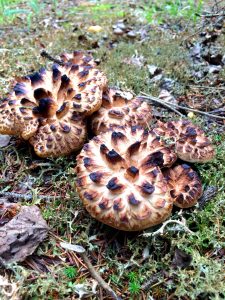

Hawk’s wing[v] closely resembles the hedgehog mushrooms, except for being darker in color. They, too, have spines. They are edible, but the flavor is variable, sometimes good, sometimes unpleasantly bitter. This may in fact be two species mistaken for one.
White Matsutake (Tricholoma sp.)
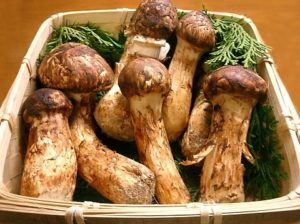

Matsutakes [vi]are a group of very popular edible mushrooms prized particularly for their rich and unique scent, especially in Asia. The name “White Matsutake” refers to three species in North America. All three look pretty much identical and are best differentiated by where they grow—their ranges don’t overlap[vii]. Montana includes the ranges of at least two of these species.
Giant Western Puffball (Calvatia booniana)
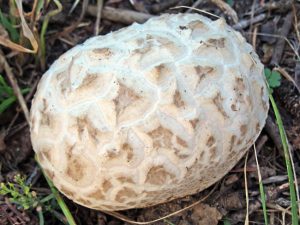

Giant Puffballs live up to their name—some can get basketball-sized, or even larger. Their size means that, unlike smaller edible puffballs, they are less likely to be mixed up with the early “egg” stages of toxic Amanitas.
A puffball is any mushroom in which the spore-production tissues are entirely enclosed. To release the spores, the mushroom must rupture. When young, many, including the giants in the Calvatia genus, are safe to eat. As soon as the initially white interior starts to go off-color or darken, though, that is a sign the spores are maturing and the puff is no longer good to eat. But the main problem with giant puffballs is that heir protein content is so high that, like meat, they must be refrigerated as soon as they are picked—and they don’t always fit in the refrigerator! They can be grilled, though their soft texture is not everybody’s favorite. They can also be dried to make a powder useful in breads and soups.
Oyster Mushrooms (Plurotus sp.)
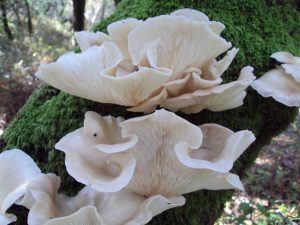

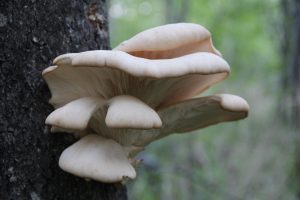

Oyster mushrooms are so named because many of them look a bit like oysters. Their flavor is delicate, sometimes almost perfumed. Their texture is also delicate, so they are seldom sold, but many species are easy to cultivate. Montana has at least two species, Pleurotus pulmonarius and Pleurotus populinus.
Our Recommended Field Guides for Montana
COVER | TITLE | Header | ||
|---|---|---|---|---|
OUR #1 RATED | ||||
Poisonous Mushrooms in Montana
The following list is not exhaustive; please don’t assume something is safe to eat just because it’s not here.
Deciding which species should be here is itself a little difficult, since there are a great many mushrooms that are safe to eat sometimes, for some people, but not other times for other people. Sometimes the problem is simple allergies, or the mushroom has to be cooked or properly processed or only harvested at a certain stage to be safe to eat. In other cases, the variable is more mysterious. It’s possible that the amount of toxin in some species is inconsistent or that some people are more sensitive than others—or both.
When looking up whether a given species is edible, you may find different answers in different sources. What you’re seeing is, for the most part, judgment calls. Different people make different ones.
Destroying Angel (Amanita bisporigera)
The destroying angels are a group of large, handsome, white or whitish mushrooms that kill most people who eat them. Of course, nobody eats them on purpose, but they are sometimes mistaken for virtually all edible white mushrooms, no matter how vague the resemblance. It’s important to remember these are not mistakes made only by ignorant or foolish people—a moment of inattention or wishful thinking can kill. If you do eat a destroying angel, don’t despair. Prompt, appropriate medical treatment can save some victims.
There are multiple destroying angels across North America and Europe. This is Montana’s species.
Deathcap (Amanita phalloides)
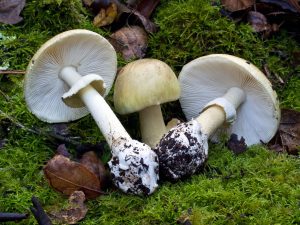

The Deathcap looks very much like a greenish or brownish version of the destroying angel, and it contains the same toxin at a similar concentration. This species may have killed more humans than any other mushroom (among other issues, it has been implicated in several murders).
It is not native to North America[viii]. It has been brought in accidentally on the roots of trees used in landscaping. It does not spread easily on its own, so in Montana it is likely to pop up only in urban or suburban areas with trees planted by nurseries. Unfortunately, there is no way to remove the fungus once it is established, and no way to tell it is present until it fruits. And since the deathcap fungus does not fruit until it is at least several decades old, there are doubtless neighborhoods that have deathcap infestations that are still hidden underground, waiting.
Deadly Galerina (Galerina marginata)


The Deadly Galerina has the same toxin as the Destroying Angels and Deathcap, though it is not closely related to them and does not resemble them. It is small, brownish, and nondescript. Unfortunately, many edible species and nearly all the “magic” mushrooms are also small, brown, and nondescript. Deadly Galerina even shares its habitat with some of its look-alikes and can grow in mixed clumps with them. That means it is possible to find a clump of basically identical-looking mushrooms, carefully identify all but one in the clump as some favored edible, harvest the entire clump, and then die because that last one was a Deadly Galerina.
Fly Agaric (Amanita muscaria)
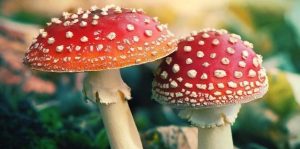

Fly Agaric, often known simply by its scientific name, is psychoactive, and we have listed it in the “magic mushroom” section of some state profiles. However, its active ingredient is not psilocybin, and it also contains a powerful toxin. While it seldom kills people who eat it, it is a dangerous mushroom. Proper processing can reduce the toxin load to the point that the mushroom can be used as a mind-altering drug, or even to the point where it can be eaten in small quantities as a culinary mushroom, but mistakes in processing can be dire.
False King (Boletus huronensis)
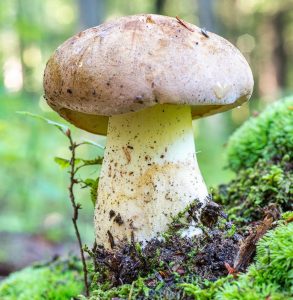

The False King[ix] is a close look-alike of the delicious King Boletes, though careful attention to detail will make mistakes unlikely—they are not identical-looking. Curiously, one sign that you may have a False King is an unusual lack of insect damage. Apparently, bugs don’t like False Kings.
Some people have eaten False King without trouble and report that it has an enjoyable flavor. However, others get unpleasantly ill. It’s best to avoid this species.
Jack O’Lantern (gh)
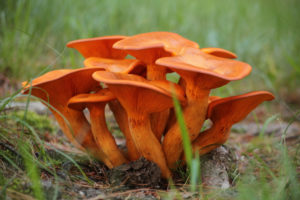

The Jack o’Lanterns are a group of mushrooms that vaguely resemble some Chanterelles and are sometimes mistaken for them—though jack o’lanterns have gills and chanterelles don’t. People who make the mistake generally survive, but the experience is extremely unpleasant. Jack o’Lanters also are said to glow in the dark, but the glow is often extremely hard to see. Some people have never seen it, and not for lack of tryin.
False and Early Morels
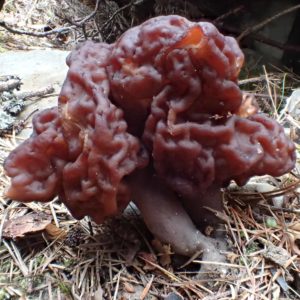

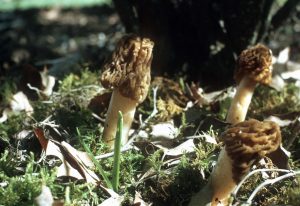

There are several genera of fungi whose fruiting bodies bear a superficial resemblance to morels but have varying concentrations of toxins. Montana has at least two of these, Gyromitra esculenta, a false morel, and Verpa bohemica, an early morel. Both are sometimes eaten without difficulty, and indeed false morels are a favorite edible mushroom for some people. There is some indication that the toxin may be cumulative, however, meaning that symptoms may suddenly appear after years of eating these mushrooms without apparent ill effect.
Our Recommended Field Guides for Montana
COVER | TITLE | Header | ||
|---|---|---|---|---|
OUR #1 RATED | ||||
Magic Mushrooms in Montana
Montana has several species of psychoactive species growing wild[x], though none are especially potent or popular among psychonauts. People considering using these species should be aware of some risks. Most obviously, possession or use of psilocybin in any form is illegal in Montana at the state as well as the Federal level[xi]. Penalties can be draconian. Second, these mushrooms bear more than a little resemblance to certain poisonous species, most notably the Deadly Galerina. Mistaking one for the other will likely kill you. And of course there are some risks associated with psilocybin use itself—these should not be exaggerated, but they should not be ignored, either.
Banded Mottlegill (Panaeolus cinctulus)
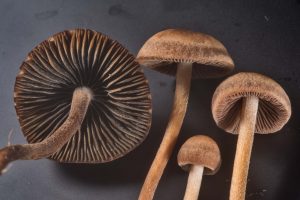

The banded mottlegill is a widespread, moderately-potent psychoactive mushroom. It is called banded because the rim of the cap is paler than the center. “Mottlegill” refers to the way the spores of this genus mature unevenly, producing a mottled appearance. Curiously, psychonauts rarely call any of the Panaeolus genus “mottlegills,” though it is a charming name. They just call them “pans.”
Gymnopilus sp.
The “gyms” are psychoactive, but they seem not to be very populary, as there is very little published information on what using them is actually like. Their taxonomy is also in a state of flux, making it hard to determine which gym is which.
Pholiotina smithii
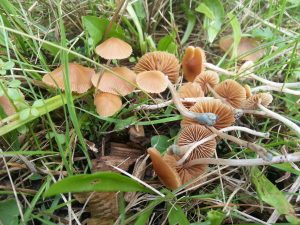

This here[xii] is a teeny-tiny mushroom that sometimes fruits abundantly. It is at least mildly psychoactive, but few people ever use it because of its close resemblance to toxic species.
Our Recommended Field Guides for Montana
COVER | TITLE | Header | ||
|---|---|---|---|---|
OUR #1 RATED | ||||
References:
[i] de Jaurequi, R. (2022). Wild, Edible Mushrooms of Montana. eHow
[ii] Crips, C. (2021). A Beginner’s Guide to Montana Mushrooming. Montana Outdoors
[iii] Kuo, M. (2020). Hydnum repandum. MushroomExpert
[iv] Bergo, A. (2022). The Forager’s Guide to Hedgehog Mushrooms. Forager/Chef
[v] Wood, M., Stevens, F. (n.d.). California Fungi–Sarcodon imbricatus. Fungi of California
[vi] Volk, T. (2000). Tom Volk’s Fungi of the Month for September 2000. Tom’s Fungi
[vii] Kuo, M. (2018). Tricholoma murrillianum. MushroomExpert
[viii] (2022). Toxic Death Cap Mushrooms Take Root in the Mountain West. Science Friday
[ix] (n.d.) Boletus huronensis (“False King Bolete”). The Bolete Filter
[x] (n.d.). Which Psilocybin Mushrooms Grow Wild in My Area? Shroomery
[xi] Dubley, P. (2022). Psychedelic Drug Laws in Montana. Tripsitter
[xii] Maynardjameskeenan (2012). Philiotina smithii (AKA Conocybe smithii). Shroomery


